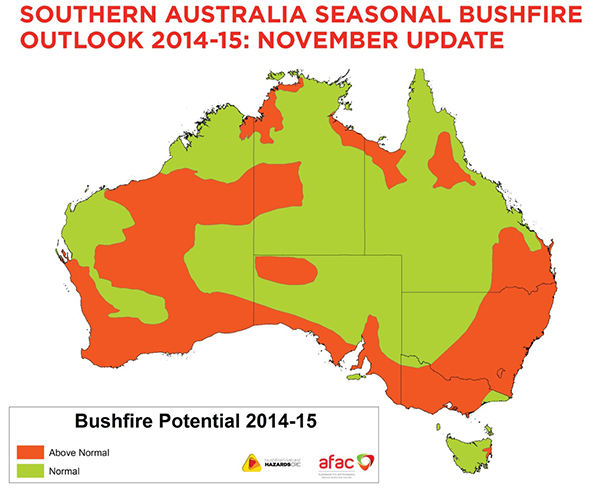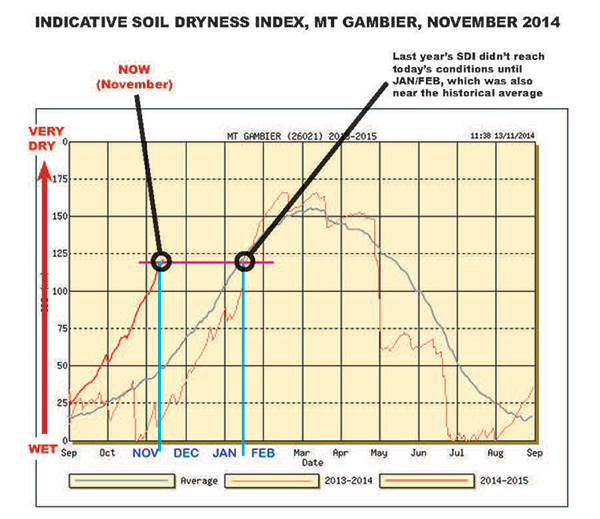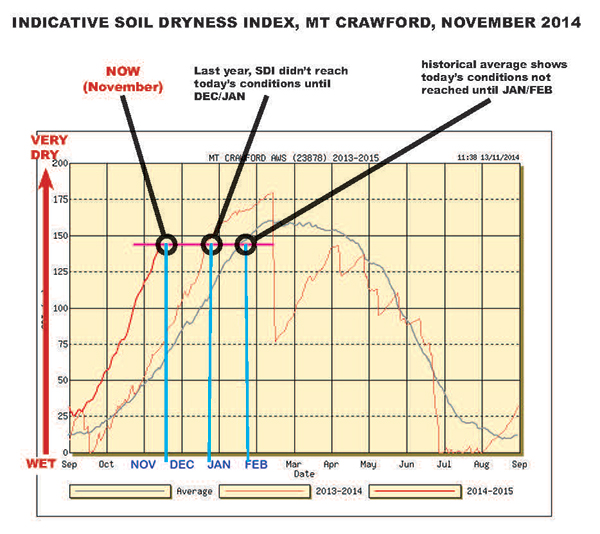CFS WARNS OF ABOVE NORMAL FIRE CONDITIONS THIS SUMMER
20/11/2014
The SA Country Fire Service (CFS) has issued new warnings about the potential for above normal fire conditions in the coming months following ongoing appraisals of meteorological and scientific data which informs fire services across Australia about bushfire risks over the summer months to come.
Examination of this data, which is used to identify areas of increased risk for strategic and logistical firefighting purposes, shows that hundreds of square kilometers of near-metropolitan and rural areas of South Australia are already experiencing, in November, a level of risk which would only normally be seen in February. The data also shows increased risks in Victoria and Tasmania.
As a result, fire-risk seasonal outlook maps set only 3 months ago have been redrawn to reflect the new reality.
Releasing details of this concerning trend, CFS Chief Officer Greg Nettleton said the research and meteorological indicators are cause for concern as we approach the hotter and drier summer months, and indicate that South Australia faces a prolonged and intense bushfire season which no-one can take for granted.
"This research, known as the Southern Australia Seasonal Bushfire Outlook and conducted in partnership with the Bushfire and Natural Hazards Cooperative Research Centre, the Bureau of Meteorology and fire services, shows that much of the State is right now experiencing a level of bushfire threat normally only experienced in January.
"The tinder dryness of vegetation coupled with low humidity and above average daytime and night-time temperatures form a perfect recipe for seriously increased fire danger," Mr Nettleton said.
"As things stand at present, all South Australians no matter where they live must be aware that January fire-risk conditions exist now in November, effectively two months early.
"In some locations, indicators show that we are actually three months ahead, which means fuels are dry and ready to be consumed if an ignition occurs.
"This dryness means that fires will be very difficult to suppress, not only in forest and scrub areas, but in grassland too.
"As the summer season progresses we can only anticipate that dryness conditions will continue to deteriorate."
Mr Nettleton said re-writing the Southern Australia Seasonal Bushfire Outlook document had not been done before.
"I can only impress on all South Australians, no matter where they live, to understand the gravity of the fire danger season this summer.
"I urge everyone – not just those in rural areas – to prepare now for the fire season ahead.
"That means reducing fuel loads around properties, cleaning out gutters and a general clean up around homes, having a Bushfire Survival Plan in place and practicing that Plan and discussing it with family and friends.
"This season, we are asking each and every South Australian to become 'ultimate' firefighters whether in CFS uniform or not; doing so will help CFS volunteers and could well save your property – and potentially your life - should the unthinkable happen.
"All South Australians need to know it's not that hard to be bushfire ready."
The re-drafted Southern Australia Seasonal Bushfire Outlook produced by the Bushfire and Natural Hazards CRC can be accessed on-line at: http://www.bnhcrc.com.au/hazardnotes

Soil Dryness Index
The Soil Dryness Index is calculated on a daily basis by the Bureau of Meteorology for a number of the forest/scrub areas of the state utilising the Mount Soil Dryness Index system. This index is indicative of the dryness of the forest fuels represented by fuel moisture content, and is important to fire behaviour for two main reasons. First, it affects the rate at which the fuel will burn, and second, the moisture distribution in the fuel bed affects the amount of fuel available to burn.



